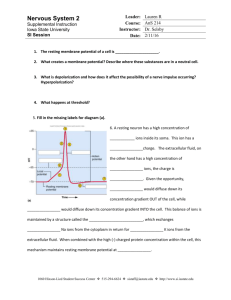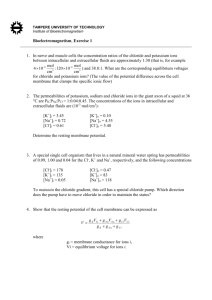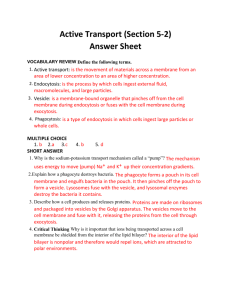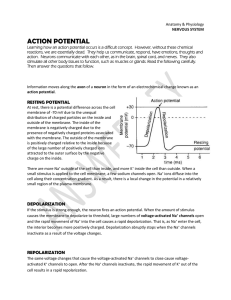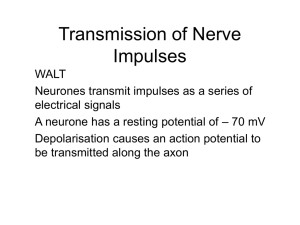Action Potential
advertisement
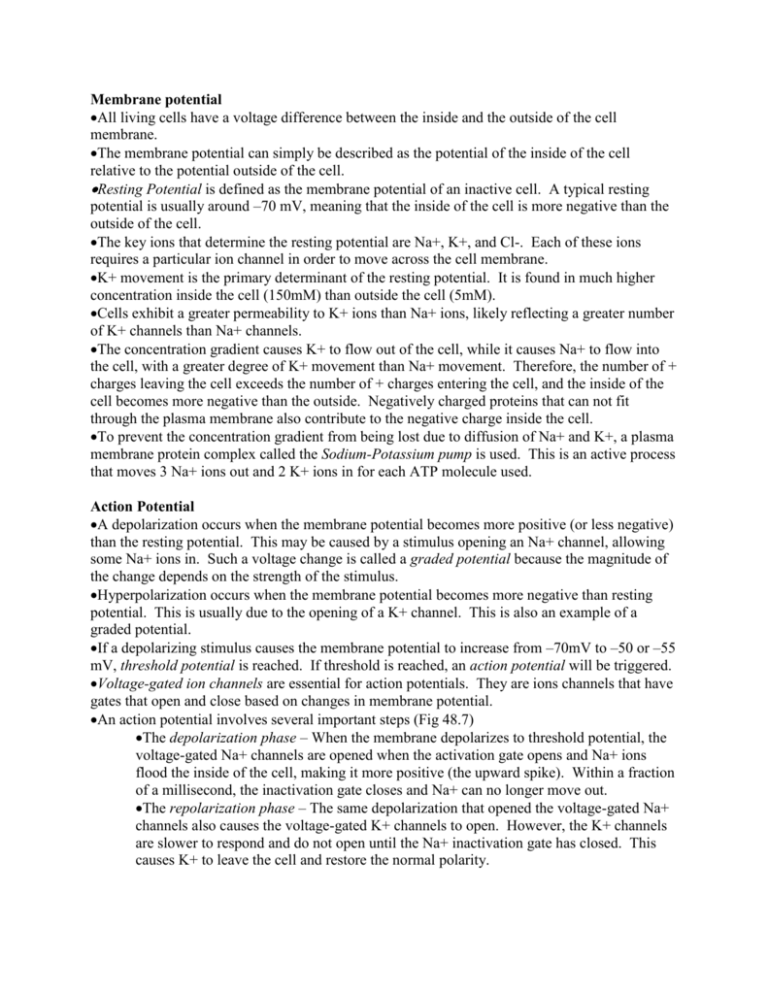
Membrane potential All living cells have a voltage difference between the inside and the outside of the cell membrane. The membrane potential can simply be described as the potential of the inside of the cell relative to the potential outside of the cell. Resting Potential is defined as the membrane potential of an inactive cell. A typical resting potential is usually around –70 mV, meaning that the inside of the cell is more negative than the outside of the cell. The key ions that determine the resting potential are Na+, K+, and Cl-. Each of these ions requires a particular ion channel in order to move across the cell membrane. K+ movement is the primary determinant of the resting potential. It is found in much higher concentration inside the cell (150mM) than outside the cell (5mM). Cells exhibit a greater permeability to K+ ions than Na+ ions, likely reflecting a greater number of K+ channels than Na+ channels. The concentration gradient causes K+ to flow out of the cell, while it causes Na+ to flow into the cell, with a greater degree of K+ movement than Na+ movement. Therefore, the number of + charges leaving the cell exceeds the number of + charges entering the cell, and the inside of the cell becomes more negative than the outside. Negatively charged proteins that can not fit through the plasma membrane also contribute to the negative charge inside the cell. To prevent the concentration gradient from being lost due to diffusion of Na+ and K+, a plasma membrane protein complex called the Sodium-Potassium pump is used. This is an active process that moves 3 Na+ ions out and 2 K+ ions in for each ATP molecule used. Action Potential A depolarization occurs when the membrane potential becomes more positive (or less negative) than the resting potential. This may be caused by a stimulus opening an Na+ channel, allowing some Na+ ions in. Such a voltage change is called a graded potential because the magnitude of the change depends on the strength of the stimulus. Hyperpolarization occurs when the membrane potential becomes more negative than resting potential. This is usually due to the opening of a K+ channel. This is also an example of a graded potential. If a depolarizing stimulus causes the membrane potential to increase from –70mV to –50 or –55 mV, threshold potential is reached. If threshold is reached, an action potential will be triggered. Voltage-gated ion channels are essential for action potentials. They are ions channels that have gates that open and close based on changes in membrane potential. An action potential involves several important steps (Fig 48.7) The depolarization phase – When the membrane depolarizes to threshold potential, the voltage-gated Na+ channels are opened when the activation gate opens and Na+ ions flood the inside of the cell, making it more positive (the upward spike). Within a fraction of a millisecond, the inactivation gate closes and Na+ can no longer move out. The repolarization phase – The same depolarization that opened the voltage-gated Na+ channels also causes the voltage-gated K+ channels to open. However, the K+ channels are slower to respond and do not open until the Na+ inactivation gate has closed. This causes K+ to leave the cell and restore the normal polarity. Overshoot – This occurs when the membrane potential becomes more negative than resting potential. This is because it takes several milliseconds for the voltage-gated K+ channels to return to their resting states. Be sure to review propagation of action potentials and saltatory conduction (P. 969-970).

